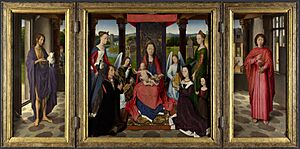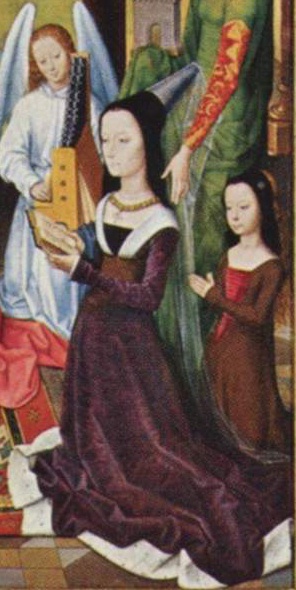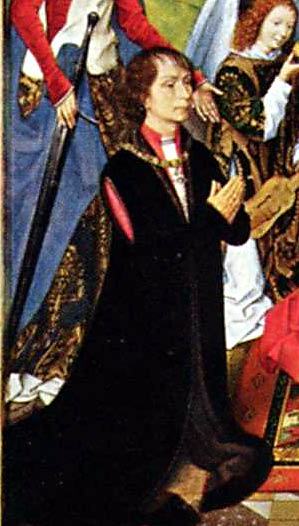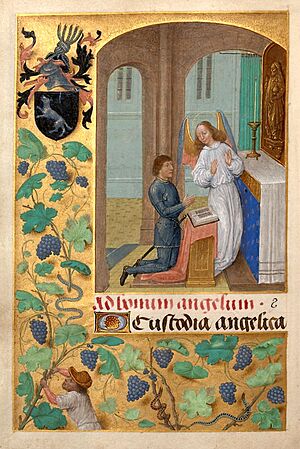Sir John Donne facts for kids
Sir John Donne (born around 1420s – died January 1503) was an important Welsh figure who worked for the English royal family. He was a courtier (someone who attended the royal court), a diplomat (someone who handled relations with other countries), and a soldier. He was a key supporter of the Yorkist party during a time of civil war in England.
In the 1470s, Sir John Donne asked a famous artist named Hans Memling to create a special painting called the Donne Triptych. This painting is a triptych, which means it has three panels. It shows portraits of Sir John, his wife Elizabeth, and one of their daughters. Today, you can see this artwork at the National Gallery, London.

Contents
Who Was Sir John Donne's Family?
The Donne family, known as "Dwnn" in Welsh, was a well-known family from Kidwelly, Carmarthenshire, in Wales. Sir John's father, Griffith, was a soldier who fought in many battles in France, including the famous Battle of Agincourt in 1415. His mother, Joan Scudamore, was a grandchild of Owain Glyndŵr, who was the last independent Prince of Wales.
Sir John Donne was born in France, probably in the 1420s. He was the third son in his family.
How Did Sir John Start His Career?
When he was a teenager, Sir John Donne began working for the Duke of York. The Duke of York was the father of Edward IV, who later became king. Sir John likely got this job with help from William ap Thomas, another important Yorkist leader from South Wales.
Sir John fought for the Duke of York in France before 1447. He also fought for the Duke in England and Ireland in the late 1440s. These early experiences helped him become a skilled soldier and loyal supporter.
Sir John's Marriage and Children
Before 1465, Sir John Donne married Elizabeth Hastings. She was the sister of William, Lord Hastings, who was a very close friend of King Edward IV. Sir John and Lord Hastings knew each other well because they both worked for the Duke of York for many years.
Sir John and Elizabeth had two daughters, Anne and Margaret, and two sons, Edward and Griffith. Both of their sons later became knights. Elizabeth Donne passed away in 1507 or 1508.
Becoming Wealthy and Important
When Edward IV became king in 1461, Sir John Donne's career really took off. He was made an "Usher of the Chamber," which was an important position in the royal household. He started to become quite wealthy. From 1465 to 1469, he was an "Esquire of the Body," meaning he was a personal attendant to the king.
After a big Yorkist victory at the Battle of Tewkesbury in 1471, Sir John was knighted on the battlefield. His wife, Elizabeth, also held a special position as a "damicellae" or Lady-in-waiting to the Queen.
In their portraits, Sir John and his wife wear fancy gold chains with suns and roses. These chains also have small lion pendants, which were the personal symbol of King Edward IV. These special chains were likely gifts from the King to his loyal followers.
Sir John's Work in Calais and Europe
Sir John Donne spent a lot of his career in Calais, which was an important English outpost in France. His brother-in-law, Lord Hastings, was the governor of Calais, and Sir John often served as his deputy. He even owned a house there.
He was part of the Calais council in 1471 and helped with important discussions in 1472 and later years. By 1483, he was the Deputy of the Tower of Risban, a fort outside Calais. Before 1497, he became the Lieutenant of the Castle in Calais. Calais was likely his main base for much of his working life.
The Famous Donne Triptych Painting
The Donne Triptych by Hans Memling was probably painted in Bruges, a city in what is now Belgium. It is believed to have been created in the 1470s. Many experts now think it was painted in the late 1470s, possibly around 1478.
The painting shows the Donne family's coat of arms (their family symbol) in a few places. You can see it behind Sir John in the painting, and also combined with the Hastings family arms behind Lady Donne.
Interestingly, the portrait of Lady Donne was first painted with a younger face. Then, the artist Memling painted over it to show her current, thinner face. This might mean that Memling only saw Lady Donne in person when the painting was already partly finished.
Sir John's Books and Art
Besides the famous Memling painting, Sir John Donne also owned special illuminated manuscripts. These were books written and decorated by hand, often with beautiful pictures.
Two of these books, which he asked artists to make for him, are now in the British Library. He also received a special book as a gift from two Duchesses of Burgundy, Margaret of York (King Edward IV's sister) and her stepdaughter Mary. This gift shows how important Sir John was to these powerful women.
Sir John also ordered an important Book of Hours around 1480. This book, now called the "Donne Hours," has a small painting of him kneeling in armor with his guardian angel. It also shows his family's coat of arms.
Many of Sir John's friends and family, including King Edward IV and the Duchesses of Burgundy, were big supporters of Flemish art. It seems Sir John was very involved in how his triptych painting was made and even asked for changes to it.
Sir John's Diplomatic Missions
Sir John Donne's official work as a diplomat began in February 1477. He and John Morton (who later became a very important archbishop) were sent as ambassadors to the French court. Later that same year, he was an ambassador to Burgundy. He went on several such missions, suggesting he was an important person in handling relations with Burgundy.
Later Life and Legacy
In 1480, Sir John bought land at Horsenden, Buckinghamshire, which became his main home in Britain. He managed to stay safe even when his brother-in-law, Lord Hastings, faced trouble in 1483. Sir John was even appointed High Sheriff of Bedfordshire and Buckinghamshire in 1485 under King Richard III.
After a new king, Henry VII, came to power in 1485, Sir John, who was also Welsh, likely made peace with the new ruler. By this time, he was old enough to retire. Both Sir John and his wife are buried in St George's Chapel at Windsor Castle, right next to King Edward IV and Lord Hastings. This shows that they were still highly regarded by the royal family.
Sir John's two sons later worked for King Henry VIII. His family line includes important noble families like the Earls of Oxford and the Dukes of Devonshire. The famous Memling painting was passed down through these families for many years.
Images for kids
-
The Donne Triptych by Hans Memling, 1470s, National Gallery, London. Sir John kneels at left, Lady Donne and a daughter at right
-
The Donne Triptych by Hans Memling, 1470s, National Gallery, London. Lady Donne and a daughter
-
The Donne Triptych by Hans Memling, 1470s, National Gallery, London. Sir John Donne








